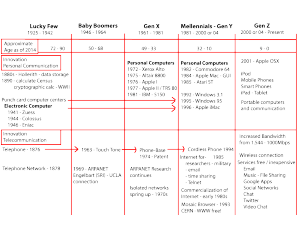To understand our relationship with technology, it is helpful to consider how it has evolved and how we have adapted/opted it. While all tools have influenced us, some have had a particular influence on our mental processes. They have provided memory storage, organization for ideas and automation for tasks. With the help of these electronic improvements, we’ve been enabled to use our mental processes differently and use digital tool to make new tools. Calculating machines (the tally stick, counting rods, abacus, and advanced calculators) evolved through the centuries improving the speed, lending innovation and automation in number and symbol organization. They were used in commerce, astronomy and time keeping.
Fast forward to the late 1800s, Herman Hollerith made significant advances to calculating with the development of a mechanical tabulator. Using punch cards, his invention not only calculated but stored numbers. These punch card machines cut years off the calculation of the 1890 census. The company he formed around this technology later became IBM and the technology spread through business and the military. Incredibly, punch card technology was relied upon until the 1980s.
Another important development, the Internet, was conceived and launched as these massive tabulation and storage machines were becoming standard. Contrary to some urban myths, the Internet was not the invention of a singe person or entity. It grew out of the commitment and focus of many visionary researchers. Conceptualized by J.C.R. Licklider in the early 60s, social networking was developed and tested through many iterations, becoming well established by the mid 1980s.

I have excerpted some of this account from a “Brief History of the Internet” authored by some of those pioneers:
In 1966 with ARPANET research there was a growth of network innovation:
“while file transfer and remote login (Telnet) were very important applications, electronic mail has probably had the most significant impact of the innovations from that era. Email provided a new model of how people could communicate with each other, and changed the nature of collaboration, first in the building of the Internet itself (as is discussed below) and later for much of society.”
With the innovation came many new three letter acronyms (TLAs) through the 70s and 80s like TCP, DNS, IGP, and EGP. All represent significant advances in the operation of networks that are still in use today.
“Thus, by 1985, Internet was already well established as a technology supporting a broad community of researchers and developers, and was beginning to be used by other communities for daily computer communications. Electronic mail was being used broadly across several communities, often with different systems, but interconnection between different mail systems was demonstrating the utility of broad based electronic communications between people.”
As the Internet developed, so did computing. As computing came to the personal desktop, the Internet became more accessible to non-engineers with a graphical interface and hyperlinks. The first desktop browser, called Mosaic brought this to the public in 1993.
So, contrary to typical commercial endeavors, the Internet was not created by a single entity to profit a few. Rather it was developed by a federation of researchers, from many countries and disciplines. Not only did they use the system to share information, they used it to create and extend their facility at sharing. They worked to lay a groundwork that would further more development of the same spirit, creating “a general infrastructure on which new applications could be conceived”.
Reading the “Brief History…” you can appreciate the community of people and their strong intention to build it as a public space; accessible, “free”, democratic and transparent for future developers.
“The Internet as we now know it embodies a key underlying technical idea, namely that of open architecture networking. …In an open-architecture network, the individual networks may be separately designed and developed and each may have its own unique interface which it may offer to users and/or other providers, including other Internet providers.”
Whether we acknowledge it or not, the advances in mobile and network technology that we enjoy are predicated upon this “open architecture”. It would be easy to overlook how well our computers, mobile phones, tablets and all the applications operate. The fact that you can keep up to date with family and friends on social networks is thanks to these people and these standards and values. Your video calls, “likes”, medical information, and entertainment are available at the click of a mouse, touch of a screen.
While the “Founding Fathers” of the Internet could not predict the particular course of “App” development, they established a framework and an environment that was conducive to it’s growth. While we might be challenged by the speed at which technology is evolving, I hope we can stay grounded in the values that keep it open and available to the masses.

